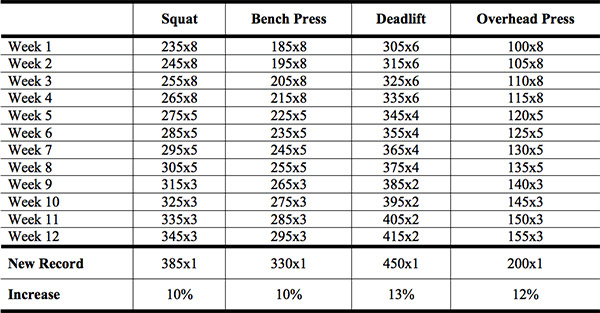
What we bring to the party
Pure hellacious strength: the preeminent athletic attribute
Featured Strength Equipment: bench press, barbell
The great 20th century Zen philosopher, Inspector Harry Callahan, once quipped, "A man has got to know his limitations." These words deeply resonated with me when I first heard them in 1971. Implicit in that statement is that a man must also know his strengths. The two sides of the same coin are, know your strengths and advantages and know your weaknesses and limitations.
I got my facts straight very early on about strengths and weaknesses. I mentored under national and world champion strength athletes in the 60s and 70s and they were continually pointing out my weaknesses and my limitations and proscribing remedial iron therapies that I was expected to incorporate in order to overcome my shortcomings. I wasn’t allowed to continually play to my strengths. For that I shall forever be grateful.
Alpha males left to their own devices will train the hell out of their strengths (that’s why they’re strengths) while ignoring their weakness. If not caught and corrected, this leads to chronic imbalances. I wasn’t allowed to develop chronic imbalances: I had direction from above. Since then, I have made it my life mission to be keenly aware of my limitations and weaknesses. That’s where the progress hides.
I also know my strengths. In a nutshell, my strength is my knowledge of how to acquire strength and build muscle. I possess rarefied knowledge on how humans can become much more muscular and much, much stronger. That’s it. I know nothing else. This is my strength - I am a mile deep. My strength is my also my limitation in that this is all I know - I am an inch wide. I understand my limitations and don’t espouse knowledge one inch outside my pie-sliver of expertise.
However within my sliver, I bow to no man. Our guiding principle is the idea of doing fewer things better. We pride ourselves of being purposefully primitive. These are little clichés we use when talking to the uniformed and ill informed about the transformational process. As it turns out, this bit of knowledge I possess, i.e., how to acquire muscle and strength, is the most coveted of all athletic bio-motor skills and attributes.
Amongst the five bio-motor attributes, strength, speed, endurance, flexibility and agility, strength is the first amongst equals. Why? Strength bleeds over into speed (there is no speed without strength) and even into endurance - think "strength/endurance," the type and kind of training used in elite MMA training. Strength/endurance requires extreme muscular exertion be injected into a cardio format.
Strength is so predominant that imbalances necessitated gender divisions and weight classes. Women can develop endurance, agility and flexibility equal to their male counterparts of the same physical size. Woman cannot develop strength or speed equal to men their size. There are very little strength differences between prepubescent males and females; this changes with the onset of male puberty when boys suddenly get fuel-injected with testosterone and as a result, muscle up.
Strength differentials necessitate weight classes: MMA superstar BJ Penn at 145 pounds, has far better endurance, flexibility, agility and a better skill set then 245-pound Mark "The Hammer" Coleman. The one category Mark is demonstrably superior is size and strength: however the disparity is so gargantuan that a fight between the two would be sanctioned manslaughter. The little man would be manhandled like a parent controlling a 10-year old child throwing a tantrum.
While we say "size and strength" disparities, we cannot imagine BJ having any difficulty subduing an untrained 245-pound "normal" man. Factually it is not size and strength disparity, it is a strength disparity singular that creates the need for gender and weight classes.
The wisdom bestowed upon me by my strength mentors has stood the test of time, though I have added some subtle thematic variations to the original core themes. However, the core essence remains unchanged and undiluted. Our philosophy is simple: use crude tools to get super strong in the core lifts. Want way bigger pecs and triceps? Add 75-pounds to your bench press. Want way bigger legs? Work up to a 500-pound raw barbell squat. Want to make your back thick and powerful? Get a 2.5 x bodyweight deadlift, or a 250-pound power clean.
Think like a lifter: put 100% of your effort into getting bigger lifts and humongous muscles will be the unintended consequence. Get way stronger in the core lifts. Simple as that. While a competitive bodybuilder might perform 300 to 500 sets per week in order to complete his bodybuilding resistance regimen, a world champion powerlifter might only perform 50 total sets per week. The trade off is in return for doing 1/10th the work the powerlifting champion needs to generate 102% effort.
Less works if less is dramatically more difficult. A bodybuilder will routinely perform 20 sets for the thighs alone, twice a week, for a total of 40 sets. World powerlifting champion (and current world record holder in the squat) Kirk Karwoski would work up to one all out set of squats once a week - nine total squat sets per session and only one session per week - but that all out top set has been as high as 900-pounds for 5 reps.
How would an intermediate-level minimalism resistance-training template lay out for a serious fitness type seeking to take current strength capacities to the next level? Here is a hypothetical periodization chart we have before; it is illustrative of the type of planning the serious strength athlete uses to systematically improve: each successive week, up the training poundage relentlessly; this in preparation for a competition or training camp. Let’s assume this is a good athlete that has a 350-pound squat, a 300-pound bench press, a 400-pound deadlift and a 180-pound overhead press heading into the cycle. The weights listed are performed after warm-up sets.

Create your own "cycle"
In a nutshell, the way to periodize or "cycle" any lift is as follows...
- Create a realistic goal
- Establish a realistic timeframe
- Reverse engineer: work backwards with a calendar/computer
- Place the realist goals within a specified timeframe
- Work backwards to establish weekly poundage benchmarks
- Start off well below capacity, build momentum, end well above capacity
- Every 3-4 weeks, alter the variables
- When instituting changes, make them dramatic, not minor
To build muscle, think like a lifter, i.e. seek to dramatically increase performance in the core, Old School progressive resistance exercises. Each week, come hell or high water, up lift performance, relentlessly, without any degradation in pristine technique. If you want to add muscle and power, this is the classical prescription.
About the Author
As an athlete Marty Gallagher is a national and world champion in Olympic lifting and powerlifting. He was a world champion team coach in 1991 and coached Black's Gym to five national team titles. He's also coached some of the strongest men on the planet including Kirk Karwoski when he completed his world record 1,003 lb. squat. Today he teaches the US Secret Service and Tier 1 Spec Ops on how to maximize their strength in minimal time. As a writer since 1978 he’s written for Powerlifting USA, Milo, Flex Magazine, Muscle & Fitness, Prime Fitness, Washington Post, Dragon Door and now IRON COMPANY. He’s also the author of numerous books including Purposeful Primitive, Strong Medicine, Ed Coan’s book “Coan, The Man, the Myth, the Method" and numerous others. Read the Marty Gallagher biography here.

